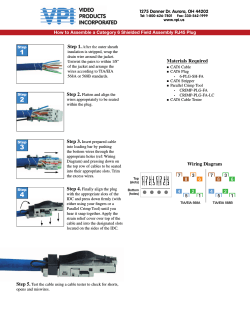
Rapid PCR for Integration in Sample-to-answer Analysis Platforms Introduction
Rapid PCR for Integration in Sample-to-answer Analysis Platforms S. Brunklaus1, T.E. Hansen-Hagge2, J. Erwes1, J. Höth1, M. Jung1, D. Latta1, X. Strobach1, C. Winkler1, T. Röser1, M. Ritzi-Lehnert1, K.S. Drese1, 1Institut für Mikrotechnik Mainz GmbH, Carl-Zeiss-Straße 18-20, Contact: Brunklaus@imm-mainz.de 55129 Mainz, Germany 2microfluidic ChipShop, Stockholmer Straße 20, 07747 Jena, Germany www.imm-mainz.de Introduction Polymerase chain reaction (PCR) nowadays constitutes an important and commonly applied method for a plenitude of diagnostics such as medical diagnostics of infectious diseases. Compared to conventional approaches such as Gram staining and cell/bacteria culturing, molecular tests are often not only faster but also yield rather specific information, e.g. on the type of pathogenic agents present. Results from molecular tests thereby render specific and highly efficient therapy feasible, in particular, when implemented in systems providing results directly at the point of care (POC). Here, a rather elegant solution to integrate a fast PCR in POC systems is presented, based on the moving plug concept. Microfluidic cartridge for HLA typing POC application (EC project CD-Medics) [1]. By employing simulation methods such as CFD, optimum heat transfer conditions were identified. Based on these findings a chip layout for fast and robust PCR was devised that runs 30 PCR cycles in 6 minutes. Most prominently, performance verifications were provided by testing of real samples containing genomic DNA both, from purified nucleic acids and not pre-treated whole blood. Employing simulation methods and analysing experimental results ended-up in a fast and robust PCR set-up including appreciation of key processes. Notably, the module has the potential of integration to complex sample-to-answer platforms. System Design and Results CFD simulation (ANSYS CFX) using a moving mesh as fluid plug inside a mesh representing the polymer chip surrounding the channel. symmetry plane polymer chip material Internal vortices enhance mixing of reagents mass transfer is dominated by convection. 30 Fluid plug dimensions 28 16 mm x 0.5 mm x 1.2 mm 15 mm x 0.8 mm x 0.8 mm 4.3 mm x 1.5 mm x 1.5 mm 26 24 22 t in s 20 heater mobile fluid volume in microfluidic channel 18 16 14 12 Characteristic time scales for different transport phenomena. Diffusion time scales are calculated for half of the channel height: t = x2 /(2 D) t: time, x= 1/2 channel height, D: diffusion coefficient. Plug velocity v in mm/s Internal rotation t in s Diff. mass transport t in s Diff. heat transport t in s Plug # 1 3 1 2 3 1 2 3 10 9.6 6.3 1.7 20 36 111 0.3 0.5 1.9 40 2.4 1.6 0.4 20 36 111 0.3 0.5 1.9 70 1.4 0.9 0.2 20 36 111 0.3 0.5 1.9 2 Design rationale: The plug is moved back and forward against a closed reservoir (“dead end”) by air pressure built up by a syringe pump (similar to systems reported in [2, 3]) . Wettability effects such as corner flow are reduced, because the actuating pressure built up by the pump is significantly higher than the Laplace pressures stemming from surface tension effects. The dead end reservoir is heated to avoid condensation and hence loss of reaction volume. The overall cycling time is comprised of heating/cooling time and travelling time of the moving plug. Fastest cycling times are found as a compromise between times required when the hold position over a heating zone is reached and velocity of the fluid plug. (high velocity means longer heating/cooling time but shorter travelling time). 10 Heat transfer dominated by diffusion processes (see Table left for estimates of characteristic time scales). Heater is located below the sealing foil of the channel. 8 6 0 2 4 6 8 10 v in mm/s From simulations the times t when the final temperature is nearly reached are analysed (here: 98 % of T difference). Heat transfer rates are determined by a) shape (diameter, length) and b) velocity of fluid plug. A diameter in the range of best performance in terms of rapid heat transfer is chosen. Optimum velocity is determined from experiments. Fluid plug (stained by red food colour) moving from one temperature zone to the next. (Experiments carried out on a stand-alone PCR device.) Typical temperature profile of the fluid plug obtained in experiments. Minimum in overall cycling time computed from experimental temperature profiles. Results obtained during optimisation of the PCR protocol in terms of cycling time. best results at plug velocity of 10 mm/s and 7 s annealing/elongation. Results from successful PCRs using purified genomic DNA, centrifuged blood (blood off chip), whole blood (blood on-chip). Positive tests were carried out in a conventional cycler using lysed and centrifuged blood. 230312 References & Acknowledgement [1] [2] M. Jung, J. Höth, J. Erwes, D. Latta, X. Strobach, T. E. Hansen-Hagge, R. Klemm, C. Gärtner, T. M. Demiris, C. O’Sullivan, M. Ritzi-Lehnert, K. S. Drese, Proc. SPIE, 2011, Vol. 79290, 79290D/1-5 J.-Y. Cheng, C.-J. Hsieh, Y.-C. Chuang and J.-R. Hsieh, Analyst, 2005, 130, 931-940 [2] G. Münchow, D. Dadic, F. Doffing, S. Hardt and K. S. Drese, Exp. Rev. Mol. Diagn., 2005, 5, 613-620 This work was funded by the European Commission, Seventh Framework Programme, grant agreement no. 216031, project CD-Medics, www.cdmedics.eu, and the German federal state Rhineland-Palatinate. We thank Tobias Hang for providing professional photographs of our microsystems.
© Copyright 2025





















